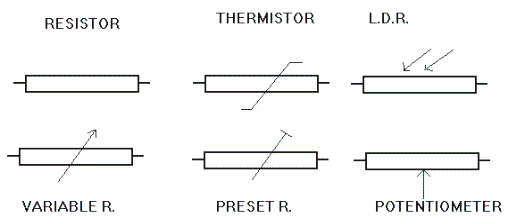|
Resistors are electronic
components which resist
the flow of electronic
current.
The higher the value of
resistance (measured in
ohms) the lower the
current will be. This
was discovered by Mr
Ohm.
The simplest resistors
are made from carbon rod
with end caps and wire
leads.
Other types are carbon
film which is a thin
layer of carbon on a
ceramic rod, and metal
oxide and metal glaze on
glass rods.
Wire wound resistors are
used where the resistor
has to dissipate a lot
of heat. Faulty resistors have
gone open circuit or
changed in value. They
never go short circuit.
Some resistors are
designed to change in
value when heated. They
are called THERMISTORS
and are used in
temperature measuring
circuits.
Some resistors change in
value when exposed to
light. They are called
LIGHT DEPENDANT
RESISTORS.
Most resistors are
colour coded to indicate
their value and
tolerance.
Wire wound resistors
have their value written
on them. (colours would
change with heat).
High stability resistors
(marked with a fifth
pink band) do not change
value easily.
Resistors generate heat.
Resistors have a wattage
rating. The higher this
rating the more heat
they can dissipate.
To limit the range of
resistor values to a
manageable number a
preferred range only is
available.
These are
1.0 1.2 1.8 2.2 2.7 3.3 3.9 4.7 5.6 6.8
8.2 This mean that 1 ohm, 12
ohm, 180 ohm, 2200 ohm
resistors etc are
available.1000 ohms is 1k,
1000,000 ohms is 1M.
3,300,000 ohms is 3.3M
etc.
Decimal points are not
used on circuit diagrams
(they may be confused
with fly specks).
3.3M would be written as
3M3 and 1.8k as 1K8 etc.
On circuit diagrams
tolerance is indicated
by the following
letters.
F=1% G=2% J=5% K=10%
M=20%
R22M= 0.22 ohm 20% 4R7K=
4.7 ohm 10% 68RJ=68 ohm
5%

Variable resistors are
available. These can be
operated by means of a
knob on the control
panel. Examples are
volume and brightness
controls. Preset
variable resistors are
internal controls which
are adjusted in value by
means of a screwdriver.
Once adjusted, they are
never touched again. |